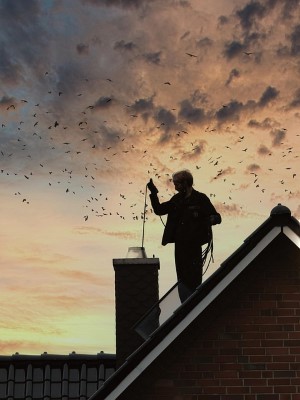BATS
BATS - LONG ISLAND, NEW YORK
Bats belong to the order Chiroptera and are the only flying mammals. Bats have forelimbs adapted as wings and are more agile flyers than most birds. During flight, a bat's heart rate can reach one thousand beats per minute, and their body temperature can be as high as one hundred six degrees Fahrenheit. There are more than fourteen hundred species of bats worldwide, with the Big Brown Bat and the Little Brown Bat being the most commonly encountered bat species by Long Island homeowners. The Little Brown Bat and Big Brown Bat are called house bats because these insectivorous nocturnal cave bats find their way into Long Island homes and roost in chimneys and attics. The Big Brown Bats have a body length of four to five inches, more than double the size of the Little Brown Bat. Big Brown Bats have a wider nose than the Little Brown Bats. The Big Brown Bat has long, silky, chocolate brown colored fur. The Little Brown Bat's fur is uniformly dark brown and glossy on the back, with a little grayish fur underneath. Big Brown Bats possess thirty-two adult teeth, and Little Brown Bats are equipped with thirty-eight adult teeth.
The Big Brown Bat's ears are short and black, and the tips are rounded, whereas Little Brown Bats, also known as mouse-eared bats, have short, blunt-tipped tragus in their ears. Female bats will create nursery roosts in the attics of Long Island homes, with several female bats giving birth in the same area. The average life expectancy of these cave bats is 6.5 years, but they can live to be more than twenty years old. Giving birth to one bat pup in the month of June or early July, bats are one of the slowest reproducing mammals. Newly born bat pups are dependent on their mothers for nourishment. Little Brown Bat pups can fly at about 3 weeks of age, feeding on their mother's milk and insects. The Little Brown Bat is weaned from its mother's milk when it reaches twenty-six days of age. The pups of the Big Brown Bats can fly at about 4 to 6 weeks of age. Once weaned, the Big Brown Bat pups will fly out of the attic in search of beetles for food. Other insects preyed upon by bats include mosquitoes, wasps, flying ants, and flies. Bats host more than sixty zoonotic viruses, including rabies, Hendra, and Nipah, which can be transmitted to humans.

BATS: SENSES AND INTELLIGENCE
The saying "blind as a bat" isn't really accurate. Bats use their eyes to see during the day, and they can see as well as humans. However, these nocturnal creatures cannot rely on their sense of sight for night-time vision and instead use echolocation to navigate and locate their insect prey in the darkness. Echolocation involves bats producing high-frequency ultrasonic waves that bounce off objects in their surroundings and return to their ears; bats can hear sounds above the range of human hearing. Bats have a highly developed sense of touch, possessing wings equipped with touch receptors that assist them in detecting and responding accordingly to air motion over their wings. This sense of touch aids bats in becoming agile aerial acrobats. Bats possess an acute sense of smell and can perceive odor sources even at very low concentrations.
Bats are highly intelligent mammals with social skills and long-term memories. They roost in colonies, form long-term relationships with other bats, and often fly in groups. Despite the small size of their brains, bats have a high level of social intelligence.
BAT CONTROL IN NASSAU COUNTY, NEW YORK
Bat Inspection is the initial step in the bat removal and control process. Humane bat removal specialists from Nassau County Nuisance Wildlife Removal Services will inspect your home or business to determine how a bat entered it and look for evidence of bat inhabitation.
SIGNS OF BATS
Bat Droppings are also known as bat guano. Piles of droppings in the attic or in the vicinity of the bat's entry points are a sign of an infestation. Histoplasmosis is an infection that results from breathing in the fungal spores often found in bat feces.
Bat Odors are identifiable as musky and ammonia odors resulting from the cave bat's urine and guano.
Bat Noises may include high-pitched squeaking and scratching sounds.
Bats may be observable roosting in the attic or may be seen exiting your home or business at dusk, evidencing an infestation of bats.
Bat Grease Marks are dark stains found at the points where bats enter and exit homes or businesses.
HOW TO GET RID OF BATS LONG ISLAND, NEW YORK
Bat Repellents - No scientific studies demonstrate that bat repellents, including ultrasonic sound-emitting gadgets and commercially available odor-based repellents, are effective in getting rid of bats.
Bat Exclusion is a proven, effective process of removing a colony of bats from a home or business. Nassau County Nuisance Wildlife Removal Services specializes in humanely removing bats from the attics of residences and commercial properties in Nassau County, Long Island. The bat removal process is implemented in the Fall when no flightless baby bats are present. Getting a colony of bats out of an attic usually takes about three days and entails setting up bat exclusion devices over their main exit points. The bat exclusion devices are one-way doors that allow the bats to leave the attic but not re-enter it. Following the removal of the bats from your home or business, the exclusion devices will be removed, and a licensed Nassau County wildlife exclusion contractor will seal the openings through which the bats were entering,